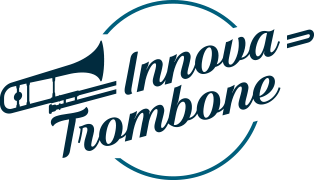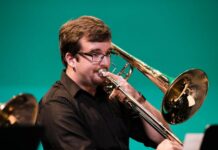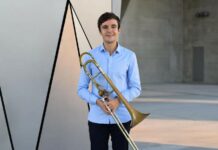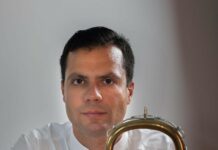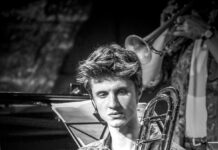From Innovatrombone we are delighted to share with our users the interview with maestro Aldo Caterina, a trombonist who has presented his research and recording work to us.
Aldo Caterina
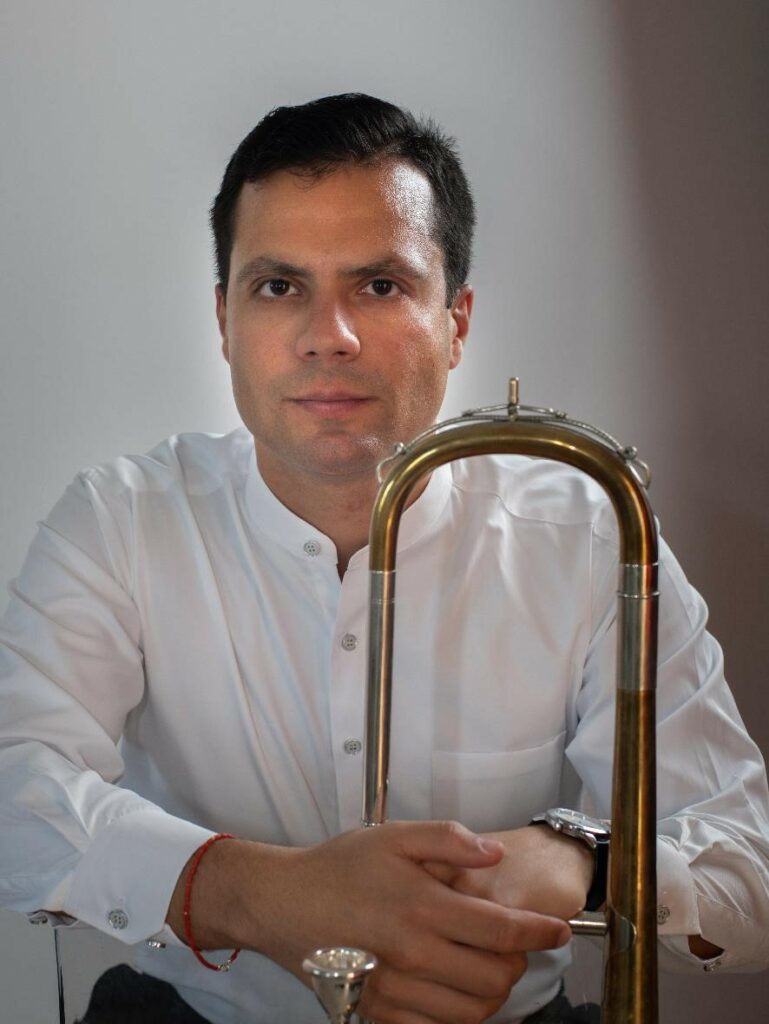
Biography: Aldo Caterina, obtained his bachelor and master’s degree in trombone at the
Conservatory of Music G.B. Pergolesi in Fermo in the class of trombonist Rinaldo Strappati with full marks and honors. He attended the course of High Specialization in Chamber Music in the class of Maestro Bruno Canino at the School of Music in Fiesole, Firenze.
He also graduated in Philosophy at the University of Macerata. He has perfected himself in the soloist and orchestral executive practice with the trombonists Abbie Conant (Trossingen-Germany) and Simone Candotto (1st trombone N.D.R. Orchester- Germany).
In November 2017 Aldo won the second prize in the soloist category and Best Italian Musician Prize in the Virtuoso Prize International Competition at the Auditorium Parco della Musica in Rome by performing the Trombone Concerto No.2 by Vladislav Blazhevich. In 2016 he won the first prize in the Chamber Music section of the Dinu Lipatti International Music Competition in Rome. As a soloist, he has gone on tour in China, Canada, Germany, Belgium, Switzerland, Croatia, Slovenia and Romania.
In 2014 and 2018 he was a guest trombonist at the Standford University Symphony Orchestra (California, U.S.A). For the Editions Da Vinci in Osaka (Japan) he released the CD Four Baßposaune concertos from Early Romantic Era 1820-1830, recording for the first time four concertos in the literature of his instrument with a German trombone of the 19th century. For the Editions Marc Reift (Switzerland) he recorded the Seven studies in the Russian style by Vladislav Blazhevich for trombone solo.
He has published the book Il trombone: la storia, il funzionamento, i modelli for the Editions Il Castello, Italy. Aldo features a unique commitment in the field of musical and organological research of past trombone models, particularly of Italian and German models of the 19th century and of the first decades of the 20th century. This systematic research activity he often led him to elaborate concert programs entailing authentic rediscoveries to the benefit of musicians, instruments and sounds that have never been performed or heard again since their era until today.
He plays trombones forged in centuries-old German workshops by craftsmen such as K.E.
Mönnich and G. Wolfram (Markneukirchen) as well as J. Monke (Cologne). On the occasion of the centenary of the World War I he was coordinator of the project Ottoni Storici Belati
promoted by the Historical Publishing House Tito Belati based in Perugia.
Since January 2017 he is a trombone contract professor at the L. Canepa Music Conservatory of Sassari and at the F. Morlacchi Music Conservatory of Perugia.
INTERVIEW:
Innovatrombone: Hi Aldo, we are delighted to meet you!
Aldo Caterina: The pleasure is all mine! Thank you for presenting my recording project dedicated to a rare trombone model and repertoire in the pages of its prestigious magazine.
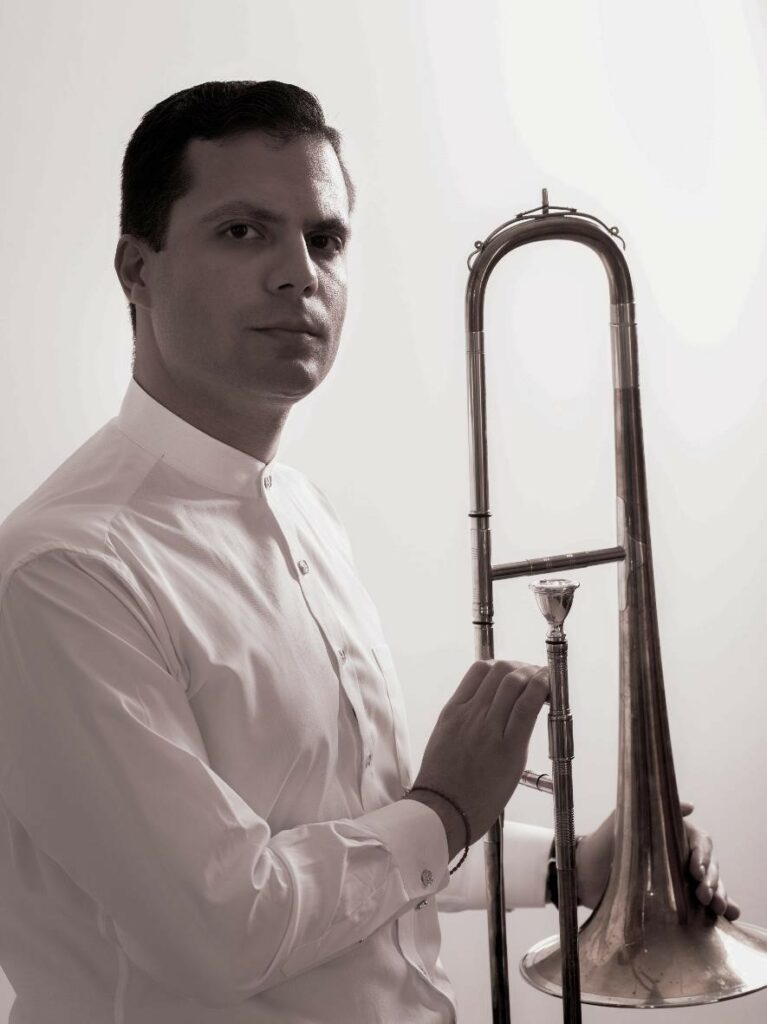
Innovatrombone: Tell us, where are you from?
Aldo Caterina: I am originally from a small town in southern Italy, Termoli. I live with my wife, Monica in Grottammare on the Adriatic Sea, in a place that is famous musically because it is where the great Franz Liszt remained in the final phase of his life and worked on his conversion to the Catholic Faith, where he also keeps the piano and the organ with which the composer worked.
Innovatrombone: The reason for this interview is that you tell us the details of your last job. A work that is based on the release of a CD, the research and the discovery of the Low German period trombone.
How did this project come about?
Aldo Caterina: The adventure of releasing this special album arises from two factors: curiosity and friendship. In 2014 I had the opportunity to test my skills in concert with some Italian trombones built between the end of the 19th century and the beginning of the 20th century by the “Tito Belati” Musical Factory in Perugia. This intrigued and stimulated me.
Following the suggestions of Mario Belati, current owner of the brand, and Francesco Duranti, craftsman of the sector, I decided to consider these ancient sound artifacts not as “scrap”, but as opportunities to revive the original sound of the voices of the orchestra. . It was an operation of philology, equal to the rediscovery of the historical piano or of the baroque orchestras.
In February 2018 my friend trombonist Francesco Verzillo invited me on a true journey of scientific speculation. It consisted of reaching one of the least known areas of Germany, Vogtland, which is a border region with the Czech Republic. It is an area rich in metal deposits, and consequently home to many companies that produce wind instruments.
Some of these companies date from the middle of the 18th century: Kruspe, Voigt, Mönnich, Scherzer, Wolfram, Schmidt. They are family businesses that pass on the traditions and secrets of instrument making from father to son. It seems that Richard Wagner often came here to find the correct calibration of the instruments he wanted to adopt in his Bayreuth orchestra. The famous Wagnerian tuba, bass trumpet and contrabass trombone have their first realizations in this artisan context.
Innovatrombone: How did you get the trombone you were looking for?
Aldo Caterina: The reference town is Markneukirchen. It was in a snowy winter in this picturesque town that I came up with the idea of recovering an obsolete instrument, the romantic trombone. The softness of its sound and the color tones that I was able to draw reminded me of my grandfather’s old vinyl records, when he made me listen to the great German orchestras: Furtwängler’s Berliner, Reiner’s Dresdner, Abendroth’s Leipziger. A very different timbre from the one adopted by today’s orchestras.
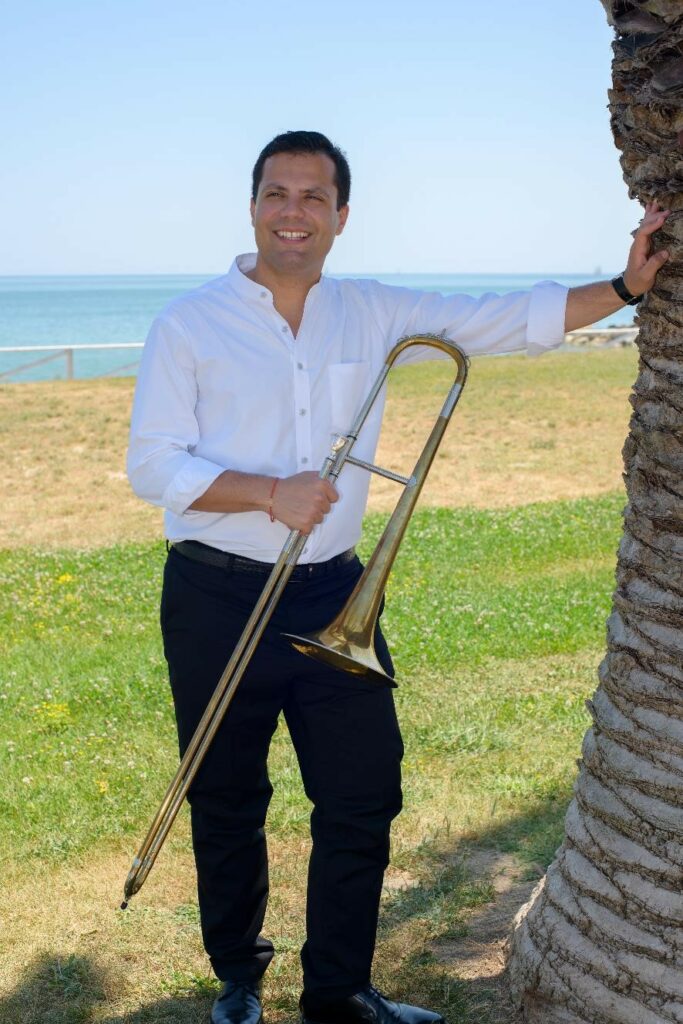
In fact, we know that, at least until 1839, the year in which the rotary valve F was invented by the instrument maker CF Sattler in Leipzig, the “bassposaune” used for these concerts (particularly of the soloist Belcke) was a bass trombone of rods in F. The instrument that took the place of the third trombone in German orchestras in the early 19th century. But following Sattler’s invention, the instrument of choice began to be a Bb trombone with an F rotor that excelled in agility, ease, intonation and beauty of sound.
That was during that trip in Markeneukirchen that I asked craftsman Gerhard Wolfram, successor to a company spanning three generations, to forge the most traditional of his trombone models: the closest to a mid-19th century trombone, a Weite trombone 3 with: (13.8 mm diameter) in Bb with F rotor and 23 mm one-piece handcrafted bell.
I wasn’t sure if I could play this romantic trombone with a modern mouthpiece … Fortunately, Joseph Klier still owned old molds for trombone mouthpieces made before WWII that mirrored all those used in the Wagnerian 19th century.
With my friend Giovanni Sabella and his piano Steinbach, Turin, 1913, in the living room of an old Italian noble Villa, we found the right balance of timbre, recorded by the sound engineer Marco Benvenuto and the microphones of the Italian company Horn. His work has preserved even the smallest technical imperfections linked to the state of the vintage instruments.
Innovatrombone: We would like to know the details about the recording process …
Aldo Caterina: For the recording process we decided to keep the trombone and piano line-up, even though most of the concertos are originally written for trombone and orchestra, because we have evidence from chronicles of the time that these pieces were also generally performed in reductions for piano in informal context or “private concerts” in the residencies of music patrons of the time. Da Vinci Publishing by Edmondo Filippini, based in Osaka, Japan, immediately supported the project, giving the album an international stage and visibility.
We have chosen almost unknown and never recorded literature for trombone from the 1820s and 1830s, which marks the transition between classical and romantic languages. The first work of the recording, Concertino mit Variationen für Bassposaune (1820) by Carl Heinrich Meyer dedicated to the soloist Friedrich August Belcke, is a theme of four movements and variations, with a heroic theme based on arpeggios and a lyrical second theme with common ornamentation at the time.
The second work on the recording was composed by Friedrich August Belcke (1795-1874). Concertino für Bassposaune Op de Belcke. 40 (1826), reconstructed and arranged from the original fragments and manuscripts from the time of American trombonist Eric Burger in 2019, is a masterpiece of technique.
The third work and final concertmaster of the recording, Christian Gottlieb Müller’s Concertino en Eb für Bassposaune (1828) dedicated to the soloist Karl Traugott Queisser (1800-1846), member of the Gewandhaus Orchestra under Felix Mendelssohn, for whom David wrote the famous Concertino in 1837. In my opinion, Müller’s Concertino is the most romantic of the recorded pieces: it has the widest range of all the works, both with extended high register and pedal register phrases in the fourth movement.
The final work is Johann Immanuel Müller’s Preludium, Chorale, Variations, and Fugue (1831), also dedicated to Queisser. It is not particularly difficult from a technical point of view, but very “intimate” and more classical than romantic in nature.
Something very important was finding the right phrasing, articulation, taste ….
I wondered: How would a solo trombone from the mid-19th century have interpreted these concerts?
I began a close correspondence with German colleagues in search of printed methods that would guarantee the adoption of the old style necessary to reproduce the atmosphere of that fertile instrumental season. Later research in the antique market led me to buy very old LPs of trombones from the past: Serafin Alschausky, Jürgen Heinel, Armin Rosin, who presented me with a unique, unusual, noble and elegant sound, as refined in the dynamics of the piano as in the fort, all oriented towards a vocal taste typical of Italian opera.
Innovatrombone: Your work goes completely against the grain, because it does not deal with the baroque repertoire so in use today, but rather with the philology of an era that is relatively close to us, but that has radically changed and is often neglected.
Aldo Caterina: The creation of this CD led me to reflect on two things.
The first is the limited instrumental and scenic international philological research for trombone with respect to the romantic period.
The second aspect refers to the influence of musical globalization. This thought occurred to me after very interesting conversations I had with builders from the former East Germany (GDR), in particular Gerhard Wolfram and Karl Ernst Mönnich. Since the end of the Second World War, American multinationals have exported the idea of the ‘superiority of the American trombone’ to Western Europe, drawing on the enthusiasm of the new generations of instrumentalists of the time, who saw in the ‘American’ trombone the opportunity to break with the past and above all to improve your technique and sound quality.
A great flourishing in the last thirty years of research in the field of Baroque, The music and metal organology of the Renaissance and Middle Ages are contrasted with an almost deserted if not a negative judgment for the Romantic period for metals … and yet, romanticism is the period in which the sound and shape of our instruments were consolidated and from which their past and above all to improve their technique and sound quality.
Through my research, I also wish to revive a sound that belongs to the great history of Europe and deserves to be preserved as heritage, enriching our awareness of a repertoire that has accompanied the evolution of great symphonic music.
Fortunately, I think something is changing and the German romantic trombone is beginning to arouse interest: I am thinking of research on the work of some musicians such as Sebastian Krause and the Verein für mitteldeutsche Posaunengeschichte association in Leipzig; the recent performances with the German trombone of an internationally renowned soloist like Ian Bousfield; the creation of a Facebook Group dedicated to this instrument that unites trombonists from all over the world who share this interest.
Innovatrombone: Dear Aldo, it has been a very interesting and enriching interview, we congratulate you on all the work you have done in favor of the German romantic trombone. Thank you very much and good luck with all your projects.
Aldo Caterina: Thank you very much to Innovatrombone for offering me the opportunity to tell my story and many thanks to all the followers of Innovatrombone.
We say goodbye with:
Four Bass Trombone Concertos of the Early Romantic Period 1820-1830 (Aldo Caterina, Giovanni Sabella)
H Berlioz “Recitativo e preghiera” per trombone and organd.
If you are a trombonist join our community, create a trombonist profile, manage your ads and videos at the following link:Register
Visit our website:www.innovatrombone.com
Follow us on : Facebook Instagram



